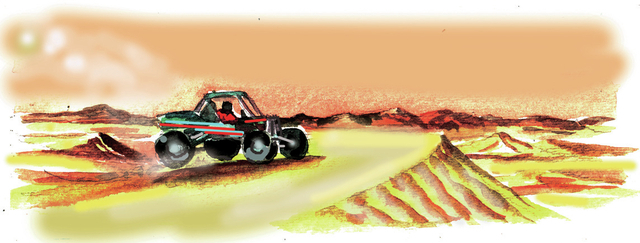Ample room to play in the sand at Dumont Dunes

Beautiful Dumont Dunes near Death Valley National Park attract more than 120,000 visitors annually. One of the great dune systems of the Mojave Desert, Dumont Dunes provide opportunities for a variety of outdoor adventures.
Off-roaders flock there for miles of off-highway vehicle challenges, especially on cool-season weekends and holidays. The area also attracts campers, hikers, wildlife watchers, photographers and those who enjoy sliding and playing in the sand.
Covering 8,150 acres east of state Route 127 in Southern California, Dumont Dunes and adjacent Little Dumont Dunes sit between the desert communities of Shoshone and Baker.
The region of sandy formations is bordered by rugged hills that channel the Amargosa River, a waterway that originates near Beatty and ends up at Badwater in Death Valley, often flowing underground. The dunes are named for Harry Dumont of the Pacific Coast Borax Co., which operated the Tonopah and Tidewater Railroad from 1905 to 1940. The old rail route lies east of the dunes.
Several highway routes access the area from Las Vegas. The longest route follows Interstate 15 about 100 miles south to Baker, then north 31 miles on Route 127, but it may be the fastest and best-maintained. Other shorter routes access the area by way of state Route 160 into the Pahrump Valley, but they may take more drive time. You can turn off on the Old Spanish Trail Highway to Tecopa and junction with Route 127 or drive into Pahrump and turn toward Shoshone on Nevada Route 372-California Route 178 and then drive south.
This expansive area of rolling sand hills topped by towering 500-foot sand peaks is administered by the Bureau of Land Management. While some sand dune systems in the Mojave are protected from vehicular access because of environmental concerns, Dumont Dunes remain open for off-road use. Visitors take to the dunes with ATVs, dune buggies, sand rails, four-wheel-drive vehicles and motorcycles.
The BLM enforces rules intended to keep the dunes safe for all users, such as allowing only one rider at a time on ATVs, wearing helmets, using seat belts or harnesses and equipping vehicles with tall masts and flags.
Vehicles must be registered or have appropriate permits. For more details on vehicle requirements, visit the BLM website at blm.gov and search for Dumont Dunes or call the BLM’s Barstow field office at 760-252-6000. Websites maintained by groups focused on off-roading also provide information and note special events.
Visitors to Dumont Dunes pay fees to drive a primary vehicle into the dunes. Fees are site-specific, and the money is used to maintain the dunes.
For occasional visits to the dunes, a seven-day pass is available for $30, $40 if the time frame includes a holiday. For frequent visitors, an annual pass makes sense. These passes cost $90 for nonholiday visits or $120 for anytime use. Obtain passes at an on-site fee machine that accepts only credit cards or at vendors in Las Vegas, Pahrump, Shoshone and Baker, all listed on the BLM website.
A staging and camping area is along the highway at Little Dumont Dunes to relieve congestion at the main dune field. Little Dumont is a favorite for beginning and intermediate off-roaders. It also provides access to taller dunes at the main Dumont Dunes area. Camping is free. Bring your own firewood. Pack ample drinking water and trash bags for camp refuse.
The main access to the major dune field is about a mile north of the staging area. Dumont Dunes Road is a four-mile graded route that crosses the course of the Amargosa River. It will take you to the base of the high dunes, where adventure awaits experienced drivers tackling knife-edged ridges and high, steep slopes.
On a busy day at Dumont, you won’t be able to hear much beyond the roar of engines, but in quiet times with dry conditions, these dunes sigh, sing and sometimes boom.
Margo Bartlett Pesek’s column appears on Sundays.












